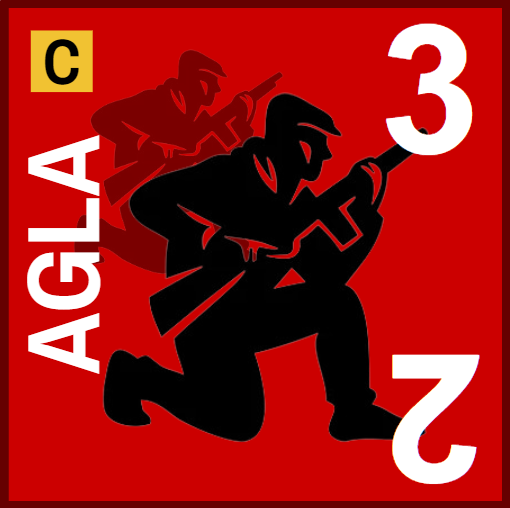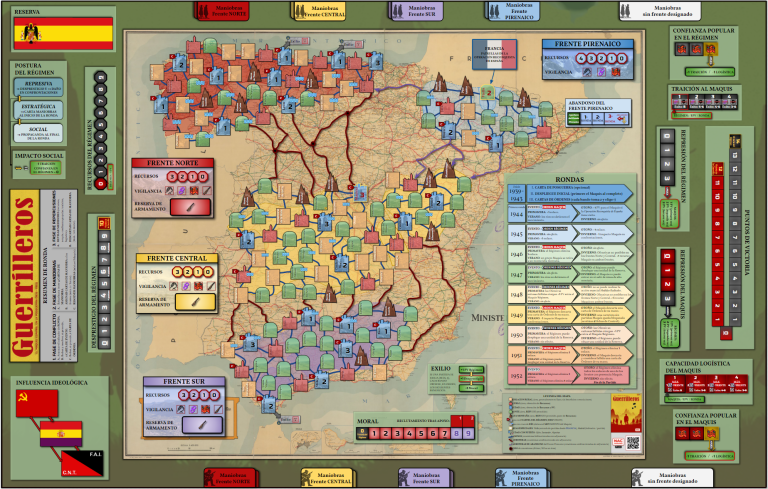
Look for the blue banner below and read this entry in English!
Guerrilleros ha sido concebido eminentemente como un juego estratégico en el que se gestionan las tropas de cada facción como bloques. En esta entrada, me centraré en describirlos en mayor detalle.
Las unidades de Guerrilleros

¿Por qué BLOQUES (y no fichas de cartón)?
La tridimensionalidad de los bloques juega a favor de un juego que tiene:
- Movimiento bajo/medio de las unidades en un mapa con muchas casillas (áreas) posibles, porque resaltan sobre el propio mapa, es fácil encontrarlas y evaluar la situación de cada frente o del tablero global.
- Apilamiento limitado, que nunca sobrepasará los 3 bloques como máximo por bando: 3 patrullas máximo en el caso del régimen, y 2 partidas más 1 armamento posible en el caso del maquis. Este número evita los (ridículos) apilamientos de juegos como por ejemplo el (por otro lado fantástico) Sekigahara, por citar uno que me encanta pero que adolece de… proporción.
- Niebla de guerra, porque los bloques revelados (tumbados) resaltan sobre los ocultos (de pie y de espaldas).
- Entidad, a falta de una palabra mejor que refleje la manejabilidad que los bloques dan a un jugador por encima de las fichas planas.
Posiblemente haya más argumentos a favor que, de forma inconsciente, puedo estar pasando por alto, pero tampoco quiero hacer un alegato a favor de los bloques. Soy consciente de que hay argumentos a favor de las fichas y que algunos de los expuestos aquí funcionan en ambos sentidos. Sin embargo, como decía al principio, este juego ha sido concebido con ellos en mente y el resultado está siendo claramente positivo.
Nomenclatura
Este aspecto es breve y sencillo. En Guerrilleros: bloque, unidad y partida/patrulla son sinónimos.
BLOQUE = UNIDAD = PATRULLA (caso del régimen)
BLOQUE = UNIDAD = PARTIDA (para el maquis)
Estructura general de los bloques: FUERZA y PASOS
Aunque cada facción tiene alguna particularidad (origen, número de pasos…), la estructura general de los bloques de Guerrilleros es extremadamente simple y análoga para ambos bandos: el único valor numérico que los bloques muestran es la FUERZA DE LA UNIDAD. La FUERZA está definida por los números indicados en las esquinas del bloque y, a su vez, el número de valores define los PASOS DE LA UNIDAD. En ocasiones, hay algún símbolo o texto, diferentes para cada bando.
La FUERZA de una unidad equivale al número de dados que esa unidad aportaría a un enfrentamiento. Se define en todo momento por el número que puede leerse de manera natural, y que siempre quedará en lado superior del bloque. Este número es en principio inmutable, aunque existen modificadores que pueden aumentar la fuerza total (o número de dados) con la que se concurre a un enfrentamiento.
Los PASOS de una unidad pueden ser uno o dos. Si una unidad tiene 2 valores numéricos de FUERZA, tiene DOS PASOS. Si sólo muestra un valor numérico de FUERZA, sólo tendrá UN PASO. Las patrullas con dos pasos se consideran unidades más fogueadas y con experiencia, y se denominan EXPERTAS. Las unidades con un único paso, menos experimentadas, se denominan REGULARES.
> PATRULLAS: los bloques del Régimen
Los bloques del régimen muestran la silueta de una patrulla (de ahí su nomenclatura en el juego) de la Guardia Civil.
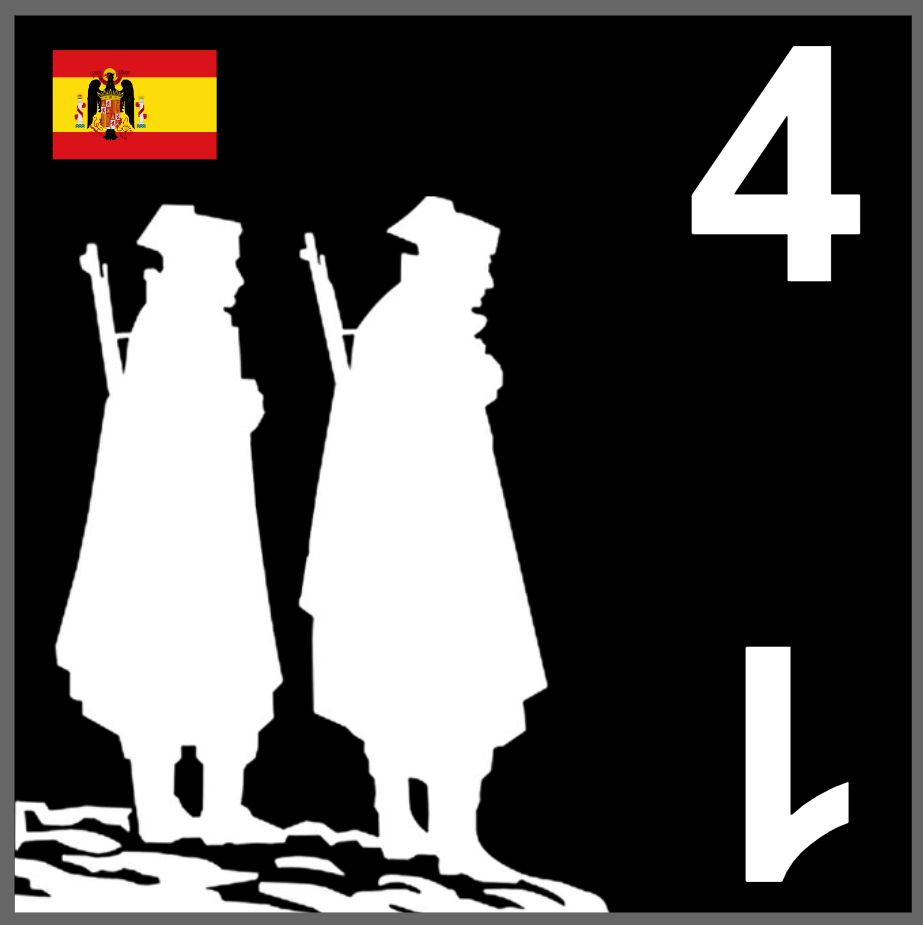

Bloque superior: la FUERZA de la patrulla experta es de 4 y dispone de DOS PASOS (es decir, está a plena potencia). Si fuera disminuida (o baja un paso) sería de 1. Es decir, aportará o bien 4 dados o bien 1 dado a los combates dependiendo de si está o no a plena potencia.
Bloque inferior: la FUERZA de la patrulla regular es de 2, y sólo tiene UN PASO así que si fuera disminuida al sufrir un daño, sería eliminada del mapa (no de la partida) y retornada a la Reserva del régimen.
Algunas fichas muestran la BANDERA del régimen franquista. Este símbolo se usa para indicar qué unidades comienzan el juego en la Reserva del régimen y pueden ser desplegadas en cualquier Cuartel del mapa. Describiré estos conceptos en mayor detalle en una entrada posterior.
Ayuda gráfica: el arte mostrado no es definitivo y los números son obvios pero, para comodidad de los jugadores, las patrullas regulares (un solo paso) muestran únicamente un Guardia Civil, mientras que las patrullas expertas muestran una pareja de Guardias. Esta ayuda gráfica se intentará preservar en el arte final del juego.
> PARTIDAS: los bloques de la guerrilla
Los bloques de los guerrilleros se denominan partidas y muestran la silueta de uno o dos guerrilleros.
Bloque superior: de forma análoga a las patrullas del régimen, la FUERZA de esta partida experta es de 3, y dispone de DOS PASOS (es decir, está a plena potencia). Si fuera disminuida (si baja un paso) sería de 2. Es decir, aportará o bien 3 dados o bien 2 dados a los combates dependiendo del paso en que esté. Además, pueden verse dos guerrilleros, indicando como ayuda gráfica que se trata de una unidad con 2 pasos o experta. Si una partida tiene una N, C o S en su esquina superior izquierda, significa que es una unidad que debe comenzar la partida en el Frente Norte, Central o Sur, respectivamente. La unidad de la imagen pertenece al Frente Central. Por último, algunas partidas expertas tienen las siglas de una agrupación guerrillera o AG. Esta imagen muestra la unidad de la Agrupación Guerrillera de Levante-Aragón o «AGLA«. Estas partidas expertas no se diferencian de otras expertas que no tengan sin siglas, salvo que las cartas de Guerrillero (que explicaré en el futuro), quedan generalmente asociadas a estas unidades. Por ‘asociadas’ debe entenderse que la eliminación de la unidad suele acarrear la eliminación de la carta de Guerrillero que menciona tal AG, si está en juego.
Bloque inferior: la FUERZA de la patrulla regular es de 1. Sólo tiene UN PASO así que se trata de una unidad regular que, si fuera disminuida al sufrir un daño, sería eliminada del mapa – y en el caso del maquis, de la partida también. Esto refleja la extremadamente inferior proporción de miembros y capacidad «regenerativa» del maquis frente a la del régimen.


Daños, pasos y eliminación de unidades
Los DAÑOS se aplican sobre las unidades haciéndolas perder un paso, lo que se materializa rotándolas 180 grados de forma que el segundo número (la Fuerza de menor valor) quede en la parte de arriba del bloque.
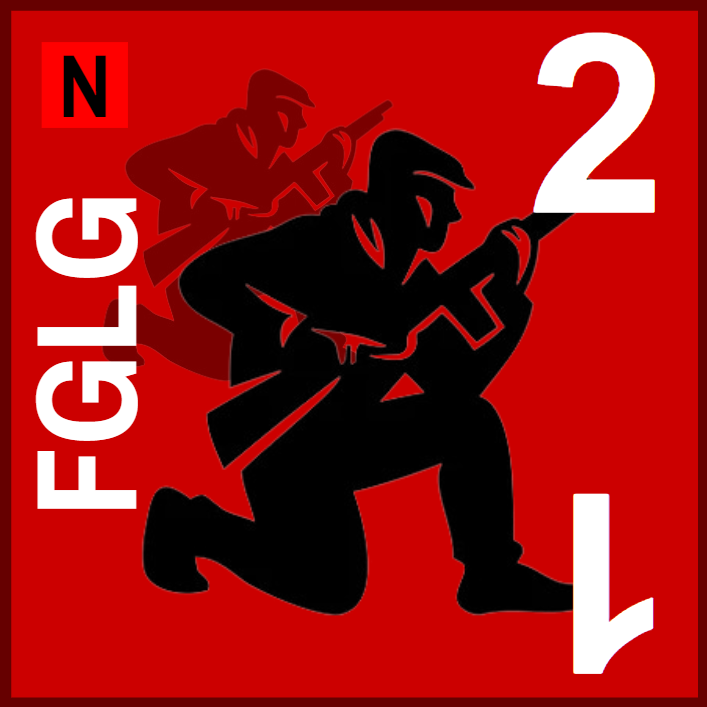
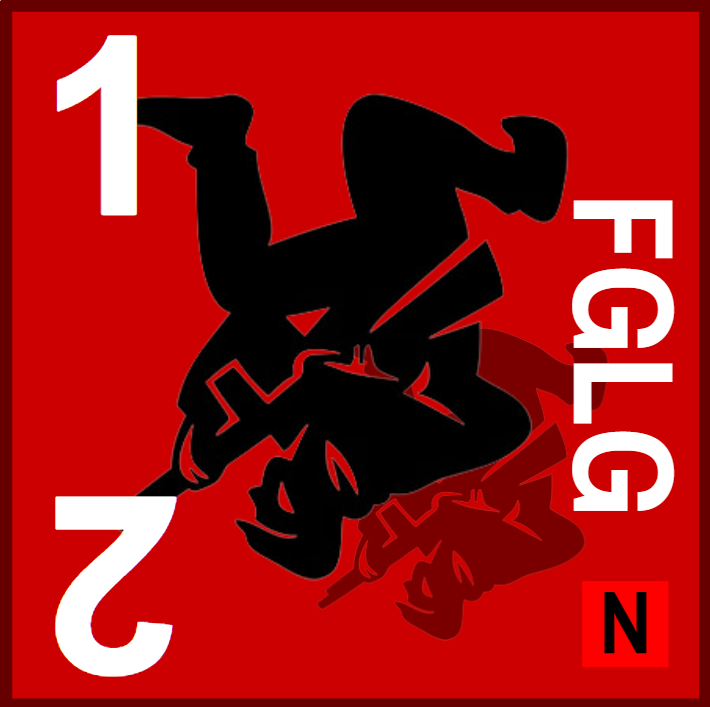
Como mencionaba en la descripción de las unidades de ambos bandos, si una unidad debe bajar un paso por daño o cualquier otra causa y no dispone de pasos restantes, la unidad es ELIMINADA.
- Las unidades del maquis eliminadas se retiran del juego.
- Las unidades del régimen eliminadas son enviadas a la Reserva y podrán volver a ser reclutadas mediante la maniobra de Despliegue. Esta asimetría refleja la virtualmente «ilimitada» capacidad militar del régimen frente al limitado censo guerrillero.
Número de bloques por bando
Continuando lo avanzado en la entrada anterior Ficha breve (pero completa) de Guerrilleros, Guerrilleros es un juego que despliega un número de unidades relativamente bajo.
El número de bloques no es definitivo pero la estimación es que terminen siendo en torno a:
- 30 +/- 5 bloques para el régimen, distribuidos de forma que suele haber 10-12 bloques por frente en casi cualquier momento de la partida, y
- 20 +/- 5 bloques para el bando guerrillero, distribuidos de forma que suele haber 8-10 bloques por frente en su momento álgido (inevitablemente irá menguando a medida que avance la partida).
De forma general, el bando guerrillero comenzará con todas sus unidades desplegadas a excepción de algunas reservadas para el escaso reclutamiento que puede hacer en el frente Pirenaico o por tener la Moral alta.
Muy bien pero, ¿qué hay del sistema de combate?
De forma deliberada, he preferido dejar la explicación del sistema de combate para una posterior entrada. Ya está diseñado y es 100% funcional, pero deseo dedicarle más atención y desarrollo para ofrecer en los enfrentamientos una experiencia realista, proporcionada y con cierto ‘sabor’ histórico.
En la última entrada ya mostré una sencilla situación en donde se simulaba brevemente un balance de fuerzas en un enfrentamiento:

Hay más etapas y detalles (nada farragosas) que aderezan y complementan el combate. Calculo que no tardaré en hablar del sistema así que os hago esperar un poco (¡paciencia, por favor!).
Dicho todo esto, termino la explicación detallada de los bloques agradeciendo a todos/as los que habéis leído esta nueva entrada y animándoos que dejéis cualquier cometario/pregunta/sugerencia en la sección de comentarios de la misma. ¡Gracias!
Y recuerda, puedes ayudar a que Guerrilleros sea publicado inscribiéndote en el programa P500 de NAC Wargames de forma gratuita y sin compromiso de compra. Entra en la web dedicada a Guerrilleros y haz clic en el botón «Apúntame» (necesitarás una cuenta de MasQueOca, ¡es fácil!). ¡Muchas gracias!

English version
Guerrilleros has been conceived primarily as a strategic game in which each faction’s units are managed as blocks. In this post, I will focus on describing them in more detail.
The units of Guerrilleros

Why BLOCKS (and not cardboard tokens)?
The three-dimensionality of the blocks plays in favour of a game that has:
- Low/medium movement of units on a map with many possible squares (areas) because they stand out on the map itself, making them easy to find and allowing the players to quickly assess the situation of each front or the overall board.
- Limited stacking, which will never exceed 3 blocks per side: 3 patrols maximum in the case of the regime, and 2 partidas plus 1 possible armament piece in the case of the maquis. This number avoids the (ridiculous) stacking of some games, e.g. the (otherwise fantastic) Sekigahara, to cite one I love but which suffers from a lack of… proportion.
- Fog of war, because the revealed (lying) blocks stand out from the hidden (standing and back) ones.
- Entity, lacking a better word to reflect the easy and comfortable handling that blocks give a player over flat tokens.
There are possibly more arguments in favour of blocks that I may be unconsciously overlooking, but I don’t want to make a case for blocks either. There is also plenty of arguments in favour of cardboard tokens and that some of the reasons given above work in both cases. However, as I said at the beginning, this game has been conceived with the blocks in mind and the result is being clearly positive.
Nomenclature
This aspect is brief and simple. When playing Guerrilleros: block, unit and partida/patrol are synonims.
BLOCK = UNIT = PATROL (for the regime)
BLOCK = UNIT = PARTIDA (for the maquis)
General structure of the blocks: STRENGTH and STEPS
Although each faction blocks have some particularities (origin, number of steps…), the general structure of Guerrilleros’ blocks is extremely simple as well as analogous for both sides: the only numerical value that the blocks display is the STRENGTH OF THE UNIT. The STRENGTH is defined by the numbers indicated in the corners of the block and, in turn, the number of values defines the STEPS OF THE UNIT. Occasionally, there is a symbol or text, different for each side.
A unit’s STRENGTH equals the number of dice that unit would bring to an engagement. It is defined at all times by the number that can be read naturally on the top side, and which will always be on the top side of the block. This number is in principle immutable, although there are modifiers that can increase the total strength (or number of dice) with which a unit enters an engagement.
A unit may have one or two STEPS. If a unit has 2 numerical values of STRENGTH, it means it has TWO STEPS. If a unit shows only one numerical value, it means it has only ONE STEP. Patrols with two steps are considered more seasoned and experienced units, and they are referred to as EXPERT units. Now, the less experienced units show only one step and they are called REGULAR units.
> PATROLS: the regime blocks
The regime blocks show the silhoutte of a Guardia Civil patrol.


Top block: The expert patrol’s STRENGTH is 4 and it has TWO STEPS (i.e., it is at full power). Were it be reduced by suffering damage, its strength would be 1. That is, it will contribute either 4 dice or 1 die to the combat depending on whether it is at full strength or not.
Lower block: The regular patrol’s STRENGTH is 2, and it has only ONE STEP so if it were reduced by taking damage, it would be removed from the map (not the game!) and returned to the regime’s Reserve.
Some counters display the FLAG of the Francoist regime. This symbol is used to indicate which units start the game in the regime’s Reserve and can be deployed in any Guardia Civil barracks or garrison on the map. I will describe these concepts in more detail in a later entry.
Graphi aid: the artwork shown is not final and the numbers are visually obvious but, for players’ convenience, regular (one-step) patrols show only one Guardia Civil, while expert (two-step) patrols show a pair of Guardias. This graphical aid will be preserved in the final artwork of the game.
> PARTIDAS: the guerrilla blocks
The maquis’ blocks are called partidas and they show the silhouette of either one or two guerrilleros.
Top block: similar to the regime patrols, this expert party’s STRENGTH is 3, and it has TWO STEPS (i.e., it is at full power). If it were diminished (if it goes down one step) it would be 2. That is, it will contribute either 3 dice or 2 dice to the fighting depending on which step it is in. In addition, the figures of two guerrilleros can be seen in these blocks, indicating as a graphical aid that this is a 2-step or expert unit. If a game has an N, C or S in its upper left corner, it means that it is a unit that must start the game on the North, Central or South Front, respectively. The unit in the picture belongs to the Central Front. Finally, some expert games have the acronym of a ‘guerrilla grouping’, or AG after its Spanish meaning «agrupación guerrillera». This image shows the unit of the Agrupación Guerrillera de Levante-Aragón or «AGLA«. These expert games are no different from other expert games that do not have no acronyms, except that the Guerrillero cards (which I will explain in the future), are generally associated with these units. By ‘associated’ it should be understood that the elimination of the unit usually results in the elimination of the Guerrillero card of that AG, if it is in play.
Lower block: the regular patrol’s STRENGTH is 1. It has only ONE STEP so it is a regular unit that, if reduced by taking any damage, would be removed from the map – and, in this case, removed from the game too. This removal reflects the extremely low member ratio and «regenerative» capacity of the maquis versus the regime’s.


Damage, steps, and units elimination
DAMAGE is applied to the units participating in an engagement by causing them to reduce steps. This reduction is accomplished by rotating the blocks by 180 degrees so that the second number (the lowest strength value) is at the top of the block.


As mentioned in the description of units on both sides, if a unit must reduce one step after taking damage (or any other cause) and it has no remaining steps, the unit is ELIMINATED.
- Eliminated maquis units are removed from the game.
- Eliminated regime units are sent to Reserve and may be recruited again through the Deploy manoeuvre. This asymmetry reflects the regime’s virtually «unlimited» military capability versus the limited guerrilla census.
Number of blocks per side
As a follow-up of the previous entry ‘Guerrilleros brief (but complete) fact sheet’, this is a game that deploys a relatively low number of units.
The number of blocks is not definitive but the estimate is that they will end up being around:
- 30 +/- 5 blocks for the regime, distributed so that there are 10-12 blocks per front at almost any point in the game, and
- 20 +/- 5 blocks for the guerrilla, distributed so that there can be up to 8-10 blocks per front at its peak (which will inevitably decrease as the game progresses).
Generally speaking, the guerrilla side will start with all its units deployed in the main fronts of the map except for some blocks reserved for the possible, not guaranteed, and limited recruitment it can do on the Pyrenean front, or for reaching very high Morale levels.
Alright but, what about the combat system?
I have deliberately left the explanation of the combat system for a later entry. It is already designed and 100% functional, but I wish to devote more attention and development to it in order to offer a realistic, proportionate and historically ‘flavoured’ combat experience.
In the last diary post I already showed a simple situation where a balance of forces was briefly simulated in an engagement:

There are more stages and details (not too complicated) that complement the combat. I expect it won’t take long to talk about the combat system in detail, so I’ll kindly ask you to wait a bit for it (patience, please!)
All this being said, I finish the detailed explanation of the blocks by thanking you again for joining me in this new entry and encouraging you all to please leave any comment/question/suggestion in the comments section. Thank you!
And remember, you can help get Guerrilleros published by signing in to NAC Wargames’ P500 program for free and no purchase obligation. Just enter the dedicated P500 website and click on «Apúntame» button (you will need an MasQueOca account, easy peasy). Thanks!


